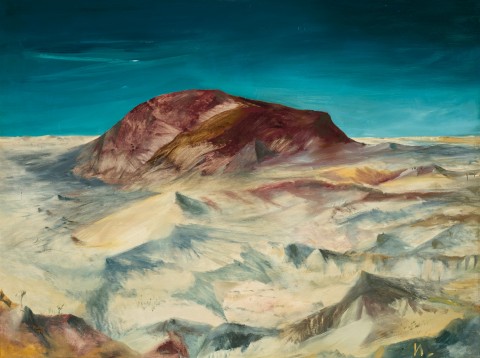CENTRAL AUSTRALIA, 1956
SIDNEY NOLAN
oil and enamel on composition board
91.5 x 122.0 cm
signed lower right: N.
signed and dated lower left: Nolan. / 1956
signed, dated and inscribed with title verso: nOLAN/ 1956 / CENTRAL AUSTRALIA
Samuel Gorley Putt, London, prior to 1968 (bears inscription verso)
Lord and Lady Snow, London
Thence by descent
Private collection, London
Sotheby’s, Sydney, 25 August 2002, lot 50 (as ‘Central Australian Landscape’)
The Cbus Collection of Australian Art, Melbourne, acquired from the above
Dawn to Dusk: Landscapes from the Cbus Collection of Australian Art, Latrobe Regional Gallery, Victoria, 31 May – 16 November 2014
Colour and Movement, Benalla Art Gallery, Victoria, 19 February – 9 June 2016
on long term loan to Gippsland Regional Art Gallery, Victoria
Nainby, B., Stanhope, Z., and Furlonger, K., The Cbus Collection of Australian Art, in association with Latrobe Regional Gallery, Melbourne, 2009, p. 228
Inspired by his extended explorations of inland Australia by rail and air with his wife Cynthia and daughter Jinx, throughout May – June 1949, Nolan’s Central Australian landscapes remain among his most acclaimed achievements. Incorporating aerial views of desert and mountain ranges, drought-stricken landscapes with dried carcasses, powerful narratives of the ill-fated Burke and Wills’ expedition, and religious iconography placed within an uniquely Antipodean context, the series not only heralded a major breakthrough in Nolan’s painting style, but established his reputation both locally and abroad as one of Australia’s most inventive and influential artists of the twentieth century. Not surprisingly perhaps, the first exhibition of such paintings at the David Jones Gallery in Sydney in 1950 was a spectacular triumph, both critically and commercially, with nine paintings selling at the opening, including Dry Jungle, 1949 to the National Art Gallery of New South Wales, and Hartz Range, 1950 purchased by Rupert Henderson, Managing Director of John Fairfax Limited, while the National Gallery of Victoria had purchased Central Australia, 1949 before the exhibition opened. By the end of the viewing, a total of seventeen paintings had been sold.1 As James Gleeson enthused at the time,
‘…Sidney Nolan’s exhibition of central Australian landscapes must be regarded as one of the most important events in the history of Australian painting. It is a superb and overwhelming experience, and it may not be too fanciful to imagine that future art historians will date the birth of a predominantly Australian idiom from this exhibition. He makes us feel the oppressive fascination of these stark unpeopled immensities of wind-worn rock and soil. And through them all runs the central theme of grinding heat, the earth is furnace-coloured under dried-up skies. Nolan’s technical equipment would seem thin and meagre in other less impassioned or more cautious hands. It achieves power and authority in his own case because it is charged with absolute conviction.’2
Although painted three years after his official ‘desert and drought’ series when Nolan had moved permanently to Europe with London as his base, Central Australia, 1956 still captures perfectly this notion of the vastness and strange beauty of Australia’s desolate interior. Featuring an almost lunar-like landscape patterned with undulating peaks and valleys, and glowing with the richness of intense ochres against teal blue nocturnal sky, the work exudes a reverence for the wild Australian outback in all its immense beauty and terror, layering fear and awe, fact and myth in a manner reminiscent of the great Romantic painters of the nineteenth century such as J.M.W Turner, Constable and Casper David Friedrich. Indeed, notwithstanding its production abroad, the painting still bears a tangible sense of the artist being present and observing with unflinching gaze the power and scale of nature; as Henshaw elucidates, ‘Allusion, suggestion and ever-present fantasy conjured up long after the visual experience has passed, in no way affect Nolan’s astonishing ability to convince the spectator that what he paints is real.’3
1. Smith, G., Sidney Nolan: Desert and Drought, National Gallery of Victoria, Melbourne, 2003, p. 25
2. Gleeson, J., ‘Landscapes triumph for Aust. Artist’, Sun, Sydney, 31 March 1950, p. 19
3. Henshaw, J., The Australian, 16 September 1967
VERONICA ANGELATOS
